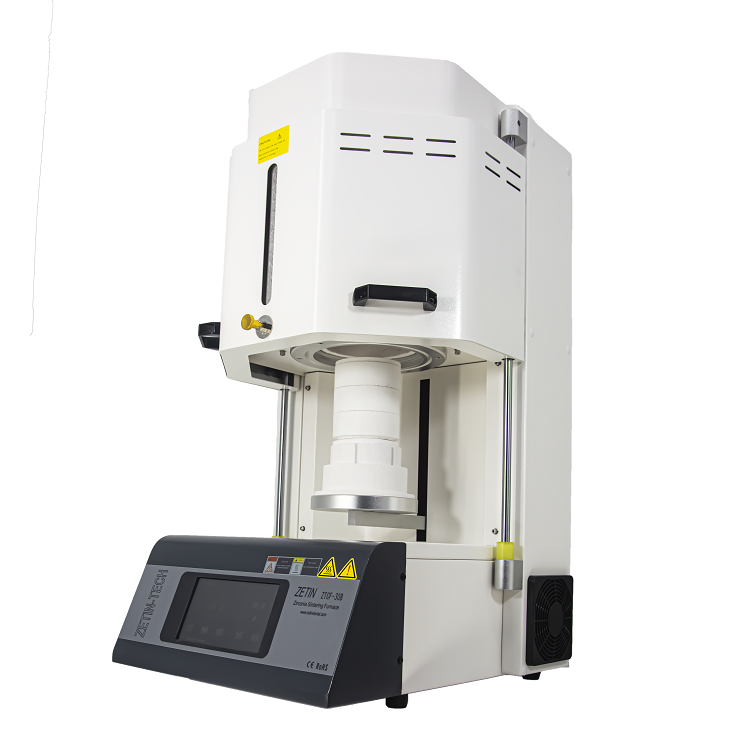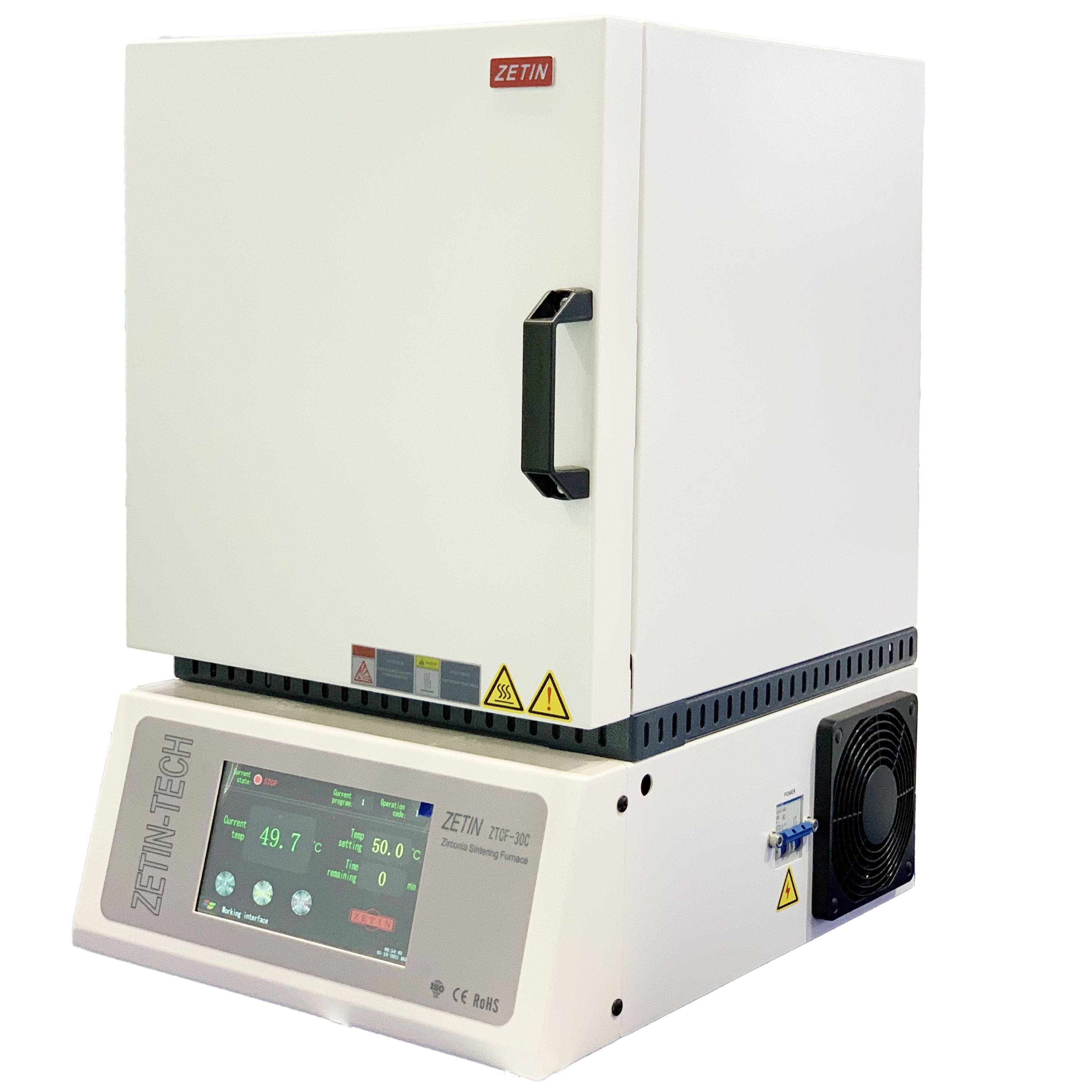There are many different models of dental sintering furnaces on the market, so how do choose a suitable zirconia sintering furnace?
Here, I take the four sintering furnaces developed by our company Zetin as examples to answer these questions.
Zetin has now launched a total of five furnaces aimed at the needs of different groups and different industries.
1. At present, the most popular and trend-required furnace is the furnace with fast sintering function, because compared with the traditional ordinary sintering furnace, the fast sintering furnace greatly shortens the need for the overall sintering process time while ensuring the perfect sintering effect. The traditional sintering furnace takes 8 to 10 hours no matter how many units of dentures you burn. A dental processing factory can only fire one furnace a day, and the efficiency is generally too low, which also leads to the high price
of dentures because the time cost is too high. For the furnace with a fast sintering function, the fast and slow integrated sintering furnace 30B plus currently supplied by Zetian,the entire firing process including heating, firing, and cooling takes only 2.5 hours. On average, it can be burned 4-5 times a day. To a large extent, the work efficiency of the dental processing plant is improved.
First of all, you need to understand that the sintering furnace is not all dentures that can be sintered with the fast sintering function, such as whole solid teeth, missing parts of relatively large teeth, etc., because these kinds of dentures are thicker, choose the fast sintering procedure, and the firing time In the short case, the innermost part cannot be burnt through, which will cause the burning failure.
Therefore, in order to avoid functional defects, the Zetin fast and slow sintering furnace 30B Plus perfectly combines the fast sintering function and the normal sintering function. It can be used for multiple purposes in one machine, set up a variety of sintering procedures, and choose different sintering procedures according to the situation.
Under what circumstances should choose the fast sintering function? What situation should choose the slow sintering function?
Generally, the factory can choose the fast sintering procedure when processing the crown, but when using the fast sintering procedure, the number of firing unit cannot exceed two crucibles and 100 crowns. The standard sintering procedure needs to be selected when firing the entire large tooth and missing bits. Standard sintering can fire three crucibles at one time, up to 150 units.
2. Aimed at dental hospitals and dental clinics, Zetin launched a small and exquisite fast sintering furnace 30B Fast. Taking into account the working environment and nature of the dentist, a sintering furnace with a small size and high sintering efficiency is needed. Because many dentists have specific customer groups, they need to be customized and sometimes need to be made on-site, so Zetin customized for the dentist group 30B fast is small in size, simple, and convenient to operate. The fast sintering process only takes 55 minutes, and it can burn 10 crowns and 5 bridges at a time. It is more convenient for dentists to provide private customized services for customers who need
customization.
3. The vast majority of sintering furnaces on the market are equipped with silicon molybdenum rod heating elements. This kind of heating element may produce polluting gases during the burning process to pollute the teeth when it is not used frequently. Therefore, newcomers lack experience or In the case of small studios that do not need to use the sintering furnace every day, it is necessary to heat the heating rods before each use, which is a waste of energy and time. For customers in this situation, we recommend that you use the Zetin silicate sintering furnace 30B SIC, this type of furnace used in the silicon-carbon heating rod, because the carbon element is particularly stable and will not produce polluting gases, so even if the furnace is not used frequently, does not need to heat the heating rod, which effectively saves energy and protects the environment. At the same time, the color of the dentures fired in the carbon rod sintering furnace will be more beautiful.
Zetin carbon rod furnace also has the function of fast sintering, so it is a relatively high-quality choice for demanding dental processing plants.
4. The box-type sintering furnace is the most traditional furnace in the industry. It has a similar appearance to many industrial furnaces, but the volume is much smaller than that of industrial furnaces. The box-type furnace is a furnace with manual doors and the maximum temperature is 1300 degrees Celsius. . It can be satisfied for the firing of many zirconia materials, but there is some zirconia on the market that require the max sintering temperature is above 1700°C box furnace can meet this condition. Many people are accustomed to the use of box furnaces, and when there are no special requirements for high temperatures, box furnaces can fully meet most of the sintering work. Moreover, the market price of the box furnace is much more affordable than the above three types of furnaces with special properties, and the price has an advantage.
Summary: There are many types of sintering furnaces, and the models are sometimes dazzling. In the final analysis, the choice of furnace model depends on the needs of the raw materials for firing. The most used raw material in the dental market is zirconia, but also metal materials. The popular e-max, glass ceramics, etc., need to use different furnaces, and different materials require different dental equipment furnaces. This raises the question, is there a furnace that can process all materials? I'm sorry to tell you that this kind of stove has not yet appeared. Maybe after the technology is continuously improved and optimized, maybe there will be such a stove in the near future. But it may not be easy to use. Because the operations involved in each process are different, each material needs to be manually operated before entering the furnace, such as engraving, polishing, coloring, glazing, etc. In the case of different production processes on the assembly line, a variety of furnaces are required to complete all the production processes of a denture.

19th Industrial Road, Mazhai Town, Zhengzhou, China 450000
+ 0086 139 3858 0592
Email:admin@zetin2005.com








.jpg)



